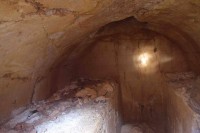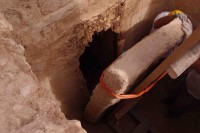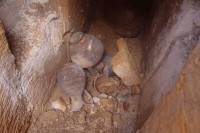 The intact tomb of an Etruscan aristocrat has been discovered in Tarquinia, a town about 50 miles north of Rome that was the first of the 12 principal cities of Etruria. The Tarquins who ruled Rome before the overthrow of the monarchy and establishment of the Republic came from Tarquinia (called Tarquinii in antiquity), and the newly discovered tomb is adjacent to a large royal tumulus known as the Queen Tomb.
The intact tomb of an Etruscan aristocrat has been discovered in Tarquinia, a town about 50 miles north of Rome that was the first of the 12 principal cities of Etruria. The Tarquins who ruled Rome before the overthrow of the monarchy and establishment of the Republic came from Tarquinia (called Tarquinii in antiquity), and the newly discovered tomb is adjacent to a large royal tumulus known as the Queen Tomb.
At just six feet in diameter, the new discovery is small compared to the Queen Tomb’s 130-foot diameter, but a location just a few feet away from the Queen’s imposing mound was so prestigious it was saved for the exclusive use of the royal family. The gentleman found buried in the new tomb is probably a prince, therefore, and perhaps even related to a Tarquin since the tomb dates to around 600 B.C., a period during which Lucius Tarquinius Priscus was fifth king of Rome (from 616 to 579 B.C.).
As with the Sarmatian tomb found this summer in Filippovka, the fact that the tomb was not assaulted by grave robbers ancient and modern, but rather has survived for 2,600 years without interference makes it an extremely important archaeological find. Tarquinia has several necropoli with a total of 6,000 tumuli. Those mounds have been targets for looters since they were first carved out of the volcanic tufa rock, so just like the Russian archaeologists, the Italians were expecting to encounter burglarized tombs with some artifacts left behind, not an intact one. The last non-tampered-with tomb in Etruria was found 30 years ago, and it had entirely collapsed so there was little data for archaeologists to retrieved.
 The grave goods found inside this tumulus aren’t as glamorous as those found in the Sarmatian tomb or some of the more famous Etruscan burials like the Regolini-Galassi tomb, but an undisturbed context of an ancient people we still know so little about is worth more than piles of gold to archaeologists. The team of archaeologists from the University of Torino and the Superintendence for Archaeological Goods of Southern Etruria were hopeful that they’d find the tomb untouched when they found the stone slab blocking the entrance to the tumulus still perfectly sealed.
The grave goods found inside this tumulus aren’t as glamorous as those found in the Sarmatian tomb or some of the more famous Etruscan burials like the Regolini-Galassi tomb, but an undisturbed context of an ancient people we still know so little about is worth more than piles of gold to archaeologists. The team of archaeologists from the University of Torino and the Superintendence for Archaeological Goods of Southern Etruria were hopeful that they’d find the tomb untouched when they found the stone slab blocking the entrance to the tumulus still perfectly sealed.
After they removed the slab, the first thing they found were remains of a sacrificial offering on the ground by the entrance: a group of jars, vases and a bronze grater all used in funerary rites. The grater was used to grate flours and goat cheeses into a vessel of wine which would then be drunk or poured as a libation.
As the heavy stone slab was removed, [University of Turin Etruscanologist Alessandro] Mandolesi and his team were left breathless. In the small vaulted chamber, the complete skeleton of an individual was resting on a stone bed on the left. A spear lay along the body, while fibulae, or brooches, on the chest indicated that the individual, a man, was probably once dressed with a mantle.
At his feet stood a large bronze basin and a dish with food remains, while the stone table on the right might have contained the incinerated remains of another individual.
Decorated with a red strip, the upper part of the wall featured, along with several nails, a small hanging vase, which might have contained some ointment. A number of grave goods, which included large Greek Corinthian vases and precious ornaments, lay on the floor.
 The vases and ornaments on the floor may have once been hanging on the wall like the little aryballos — a vessel for oils and unguents — which was so amazingly still hanging from its nail when the archaeologists opened the tomb. The heavier pieces are thought to have fallen due to structural failings of the tomb and/or seismic activity. Among the vases were seals which might help identify the deceased and fragments of what may have been armour.
The vases and ornaments on the floor may have once been hanging on the wall like the little aryballos — a vessel for oils and unguents — which was so amazingly still hanging from its nail when the archaeologists opened the tomb. The heavier pieces are thought to have fallen due to structural failings of the tomb and/or seismic activity. Among the vases were seals which might help identify the deceased and fragments of what may have been armour.
The team is still cataloguing the artifacts. Once everything has been inventoried, a panoply of tests will follow. The organic remains of the food offerings will be analyzed. One of the artifacts, a small cylindrical bronze chest, will be opened to see what’s inside. (Archaeologists expect it to contain jewelry, if anything). The tomb itself will also be explored further, in the hope of discovering other organic elements from religious rituals and to conserve the paint which, while modest compared to the elaborate decoration of some of the 200 other tombs in Tarquinia with painted walls, might make the tomb of interest to tourists.